|
AN INVITATION TO
|
TAKEO KAMIYA
|
AN INVITATION TO
|
TAKEO KAMIYA
|
The CHARM of
|
When we hear the name 'India', even though it is a distant land, there is a feeling of nostalgia in our hearts. This was the land that gave birth to one of the four major civilizations in the ancient world. It is the land where, along with China, an advanced civilization prospered. It is a great Asian nation that had an impact on all the countries surrounding it. India was also the leader of the Non-aligned Nations which was formed after the Second World War. However for us the Japanese, India is the land which introduced Buddhism to us. Before writing the name India as 'Indo' in Japanese with the kanji character phonetically, it was written as 'Tenjiku' a translation for Sindhu, an ancient name for India and was looked upon as the Paradise of the West where Sanzo Hoshi (Monk of Tripitaka) headed for in the great Chinese novel "Saiyu-ki (Record of a journey to the West)."

When European imperialists invaded India and other Asian countries, Japan was a closed country. India became a colony of the British Empire, was exploited and reduced to poverty. For a nation that was once so rich in wealth and spirituality, the image we now have of India is very confused. Moreover after the Meiji era, Japan turned its back on Asian countries including India to improve ties with Europe. We turned to West and concentrated on catching up with and overtaking them. This distorted leaning has continued up to the present age, which has further developed the erroneous image of India as being a mystical, mysterious country. Our media projects India as a mystical, magical country, but any civilization will look at people different from themselves as being mystical. Moreover European civilization and Christianity also has its own claims to mysticism as does India.
We need to recognize the true image and true value of the third world starting with India, without the tinted glass of discrimination based on economy, especially now, when Japan is at last freeing itself from being a devotee of the West. And if the culture and art of India is closely observed, one will find that, as with its music and dancing, Indian architecture too has reached stupendous heights.
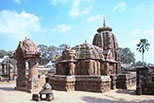
Any person who has visited India even once and seen some examples of Indian architecture has come away in awe. This is because the architecture as we know in Japan or the West differs greatly from the architecture of India. The great temples brimming over with sculptures of gods, cave temples created by digging a rocky mountain and mosques that look like they have been built only on infinitely repeated geometrical shapes, may indeed make a person feel that Indian architecture is very mystical. However, unlike pictures or literature, a building cannot exist if it is not built rationally. Any architectural culture that knows this principle, can understand that Indian architecture too has been built along rational lines. Any original expression or original thought that has been added to this rationality is the artistic form of construction. An inexhaustible supply of this architectural expression and work of art can be seen scattered all over the Indian subcontinent.
Well, India is a vast country. It is a zone of civilization that is equal to the whole of Europe geographically and historically, in its vastness and depth of culture. although it is a great nation with an unaccounted number of architectural inheritances, there is no colossal architectural plan of India. Enormous structures equivalent to the Great Wall of China, pyramids of Egypt, or the city planning of Rome, cannot be found here. Cambodia and Indonesia, which came under the influence of the Indian civilization, rather has enormous constructions in the form of Ankor and Borobudor.

In this book, I want to introduce as much as is possible the various facets of Indian architecture. I want to show this variety and receptiveness of Indian architecture through its history, geography and religions classification. Browsing through the photographs in this book, one can see the great variety. One might also be led to think that compared with European architecture, Indian architecture lacks consistency. One of the causes for this architectural diversity is the religious diversity of this vast land. Europe has believed in Christianity as a principle from medieval times and it continues to believe in it even in the present age. The difference between the Catholic and Protestant is not so glaring, and thus did not necessarily induce distinction of style in architecture. The difference is similar in degree to the differences in the Shaivite and Vaishnavite groups of Hinduism or the Shia and Sunni groups of Islam.
However, in India, apart from Hinduism, Buddhism was dominant in ancient age, and from the medieval age Islam has been. Added to this were Jainism, Sikkism and in recent centuries, Christianity. All these religions have greatly contributed to significant buildings in every urban landscape of the country. Hinduism as everyone knows is the most prominent religion in India. However, this religion differs from the Western-concept of religions. There is no founder for this religion as there is in Christianity and Buddhism. As Jesus preached Christianity and Buddha preached Buddhism , Hinduism was not preached by any one individual. It is supposed that the fundamentals were handed down from the heavens. Hinduism is a set of codes of conduct written in the "Vedas," in the epics "Ramayana" and "Mahabharata," and in the "Manu Smriti."
If Hinduism has to be summarized in one sentence it can be called an aggregated Indian way of thinking and lifestyle. It is old styled Brahminism when the system was not highly organized, and is a ceremonial religion in which only a person born in the Brahmin upper caste could interact between man and God.

Both Buddha and Mahavira were born in similar circumstances. Both were born in Bihar, in eastern India as Kshatriyas (warrior caste). After getting married and begetting children both the princes renounced their family and wealth and became shramanas or monks and after a long period of penance and meditation attained nirvana.
Jainas did not create a centralized church system, and since it was not keen on propagation, Jainism did not collect a large following.
As an ancient architectural inheritance, Buddhism has left many ruins all over the country; the relics of Jainism are scarce. What is more amazing is that there is not a single relic left of Brahmanism. Hence stating that, the ancient architecture of India is Buddhist architecture is not a fallacy.

While it had achieved an advanced stage of philosophical development, Hinduism also assimilated the native faith, gods and traditions and mores of various parts of India, captured people's hearts and became a huge system consisting of myths and codes that cannot be contained in one book of scriptures.
Buddhism that enjoyed the support of the ruling classes gradually lost its foothold after entering the age of Tantric Buddhism, heavily influenced by Hinduism and disappeared from India completely by the 13th century. Instead, it spread far and wide in the Asian countries and became a world religion and as such it is still being practiced in the northern most part of India in Ladakh and Sikkim. They follow Tibet Buddhism, which is also called Lamaism. On the other hand, early Hindu architecture followed the lines of Buddhist architecture, or converted Buddhist temples to Hindu temples. In the 7th century two unique temple styles developed for the two major gods Shiva and Vishnu, that played a major role in the stone architecture that developed 1000 years later.
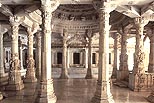
Jainism did not spread much outside India. Instead it continued to thrive in west India and has left a large amount of architectural heritage. As it was a small minority group it followed Buddhism and Hinduism in its architectural style, but in the 11 -15th century it developed remarkably in west India.
Islam that came from outside India originated in Arabia in the 7th century. Prophet Muhammad brought the words of God to the people and this was written down as the sacred book Koran. One of its most important teachings is that there is only one God and all men are equal in front of Him. With this equality concept Islam spread quickly from Spain in the west to central Asia in the east.
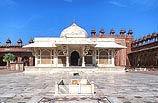
The Islamic invasion upon India started in the 11th century, and the Islamic architecture of Persia from the west was brought in. Indo-Islamic architecture reached its pinnacle during the rule of the Mughal dynasty since the 16th century, which fused the Islamic and native architecture. In the process however, the monotheism of Islam and polytheism of Hinduism collided with each other. According to Islamic faith, God (Allah) is the Absolute and his existence cannot be seen with the eyes, and so expressing or representing him with an image is absolutely forbidden. Not only that, it was prohibited to make the image form of man or animal, not to mention Prophet Muhammad. Hence not a single idol carving or mural painting can be found in the mosques. Thus the Hindu temple filled to the brim with images was blasphemy for a believer of Islam (Muslim).
It would be rash to think that it is because of this belief that Muslims completely destroyed the buildings and culture of infidels. Islam was rather tolerant to the pagans.
 Afgan Memorial Church of St. John, Mumbai
Christianity was introduce to India very early. Tradition says that the apostle Thomas came here for the mission work, but this has not been ascertained. The Roman Catholic Church was brought to India by the Portuguese in the 16th century and many churches and monasteries of the times still stand in Goa and Cochin. When Britain started governing India, the Church of England was introduced, and cathedrals and parish churches were built in various places including the four big cities. According to the national census taken in 1981, the rate of religious population in present day India is as follows. Hindu 82.6 per cent, Muslim 11.4 per cent, Christian 2.4 per cent, Sikh 2.0 per cent, Buddhist 0.7 per cent, Jain 0.5 per cent, Others (Parsi, Jew etc.) 0.4 per cent.
In present day architecture, religion does not play a main role in its development. When a new temple is built, it would be in old style on the whole. Probably the impact of religion in changing India's architecture has replaced by European and American culture and the development of science and technology.
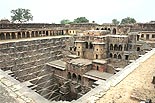
Be it India or be it Europe, there are various methods in introducing the architectural culture. Probably, since there are various religions in India, introducing architecture according to religion can also be a method. However, all buildings are not necessarily religion based. James Ferguson who had discussed the Indian architecture based on religion was strongly accused for this by E.B. Havell. According to Havell all buildings are a continuation of Indian architecture and classification according to religion is but marginal. His opinion is that if Buddhism had survived much longer it would have built temples in almost same style as that of Hindu temples, and that Islamic architecture in India was none other than the Indian architecture, is correct to a certain extent.
A more commonly used method is that of taking up style and technology of architecture historically. There is also another method of looking at the buildings of every place in geographical order.
Geographically India has a great disparity in climate with the cold Himalayas in the north, desert area in the west, and tropical rain forest in the south and accordingly the disparity in the architectural designs are also many.

What I attempted with this book was also to show the total image of Indian architecture by evenly picking up architecture forms from the Tibetian Buddhism in Ladakh in the extreme north to the wooden architecture in Kerala in the extreme south, and by not limiting to the typical style of Indian architecture in the narrow range. For this purpose, even Pakistan and Bangladesh are included in the range of Indian architecture for this book.
Apart from the classical architecture, I have also introduced colonial architecture designed by the British architects during the British rule, and the modern architecture designed after India got its independence from the British. This was because; it is thought that the colonial architecture that was built with Indian involvement is Indian architecture, as is the fact that Muslim architecture introduced to India and built in India is Indian architecture.
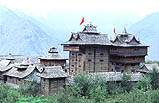
The journey of 26 chapters in search of the characteristics of Indian architecture begins with the ancient pastoral earthen mounds and caves and ends with the high-rise modern architecture of concrete and glass.
The existence of wooden structures might be most unexpected. Even after traveling two or three times to India the structures mostly seen are made of stone. There must not be many who have travelled to Himachal Pradesh or Kerala and seen the wooden buildings thoroughly.
On the other hand, the trip to the southern State of Kerala is easy, but the Hindu temples here are unwelcoming to the non-believer. Here one has to bare the upper part of the body and has to tie a white wrap called the lungi around the lower half and have to walk bare foot. Even if you are allowed to enter, cameras are not allowed. Thus, although travelling in India is not easy, every time there are new surprises and you discover something new. It is not difficult to pick up 26 keywords to explain the character of Indian architecture. However, if I am asked whether those "characteristics" have been fully explained I feel a little uneasy. There might have been other classification of characteristics of Indian architecture. Hopefully I want to make this book a stepping stone and want more young people to come up with fresh Indian architectural theory.
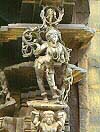
Up till now, we saw the characteristic of each keyword and its various aspects in this trip of 26 Chapters. What is the biggest characteristic of Indian architecture with all of them put together? Two things can be said about this. The first one is that since the people of India liked sculpture most among figurative arts, they wanted to make their construction also look like a sculpture.
When you visit an Indian temple you will be amazed at the carvings decorating the structure from end to end regardless of whether they are freestanding temples, cave temples, stone constructions or wooden. You begin to wonder whether the building was constructed just so that one could sculpt on them.
The Indians not only decorated the inside and outside of a building with sculpture, but considered that the whole building to be a huge sculpture. It is contrary to the thought that architecture is an art and technology to enclose 'the space' inside.
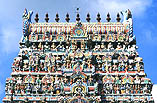
The advent of Islamic architecture reversed this trend. In Islam idol worship is completely banned. Islam forbids image-expression of sculpture, pictures, etc. and has developed the architecture of just a plain wall enclosing space.
The second characteristic is that although main Indian monuments were constructed of stone, they had held principles of wooden architecture.
  Mausoleum of Akbar and a large chhatri Probably, an ingrained feeling of beauty was more important than structural superiority or inferiority. The Islamic architecture transplanted to India was also influenced by this concept and the framework-based Islamic construction that cannot be seen in any other Islamic area, was developed. "Chhatri," a heavy domed roof supported only with thin posts and beams, without using an arch is one such type. It was clear that, unlike wood, the framework construction method where stone weak in tension is used for beam or lintel is theoretically inferior compared with the arch and dome structure where stone and brick is stacked in a radial pattern and built over a large span. Nevertheless, people from India persisted in it and completed magnificent buildings.
It resembles monophonic Indian music. Compared with Occidental polyphony (many voices) monophony is theoretically inferior. However, achievement of art cannot be compared as superior or inferior based only on principle. Even if the music of India is monophonic, with exhaustive research it has acquired an extremely advanced theory and musical expression. |
